28 Common Backyard Birds in Ohio (With Pictures)
Last Updated on
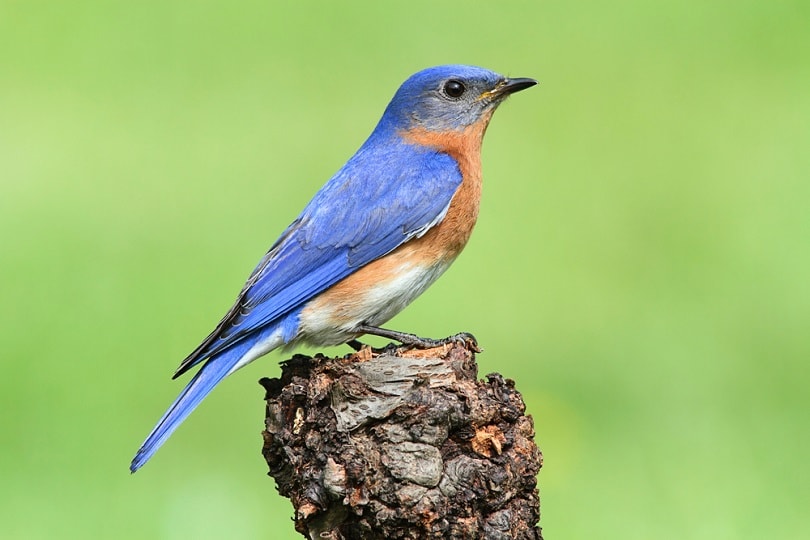
If you’re a bird lover who enjoys spectating these lovely creatures in their natural habitat, Ohio offers a lot. These birds encompass the state in various sizes, colors, and appearances. They have a variety of habitats, personalities, and diet preferences.
We scooped up 28 birds that you’re most likely to see—some of them love cities, others love suburbs, and some like to stay tucked out of sight when they can. Let’s see if you recognize any of these gorgeous, feathered flyers.

The 28 Most Common Backyard Birds in Ohio
1. Northern Cardinal
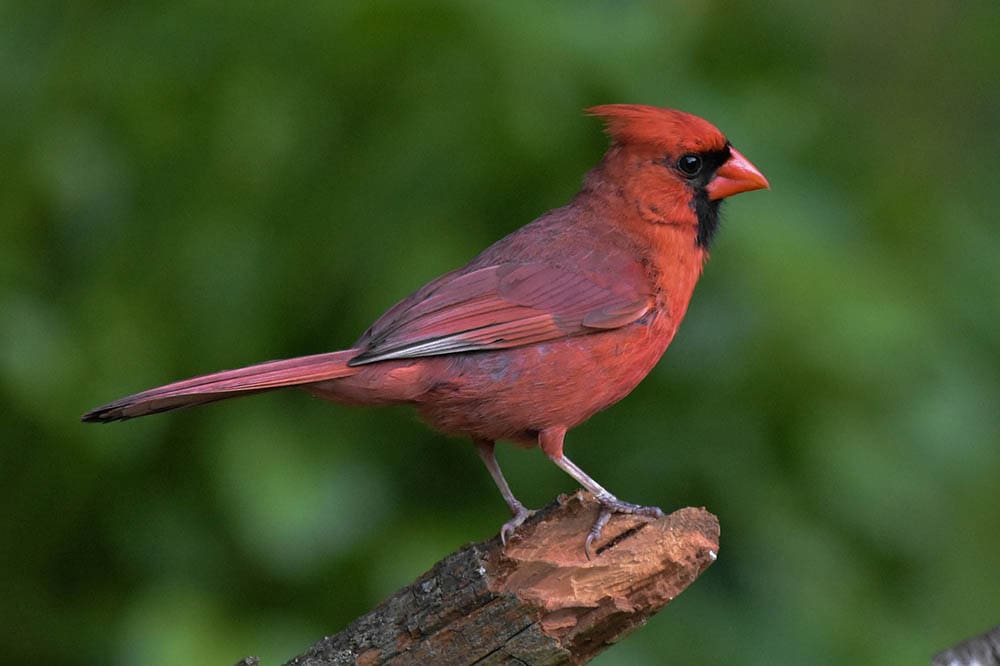
| Population: | 100 million |
| Size: | 5-9 inches |
| Colors: | Red, brown |
The Northern Cardinal is not only one of the most common and only red birds in Ohio; it is also the very own state bird! The cardinal remains iconic, and instantly recognizable due to its vibrant red color and black mask. Females are slightly different, diluted in color to more of a beige than red with orange beaks.
These birds stay around Ohio all year long, even in the frigid winter months. You can peek out and see them hopping around the snowy ground or flying through fully-leaved summer branches.
The Northern Cardinal mates for life, with a minor exception–if one mate dies, the other will move on to another partner. These familiar faces are one that every Ohioan is quite familiar with and you’re sure to see frequently.
2. American Robin
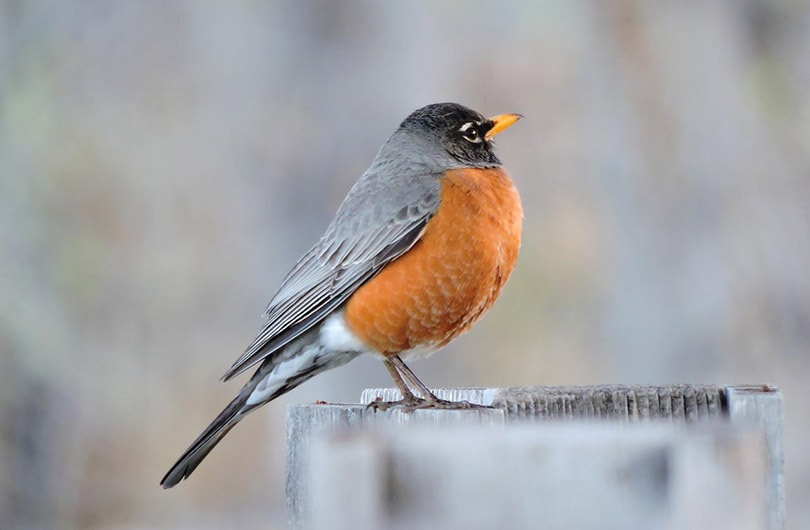
| Population: | 370 million |
| Size: | Medium |
| Colors: | Brown, orange |
Everyone knows of the beautiful robin that lays the baby blue eggs. These beauties are a surefire sign that spring is right around the corner, as they start to get super prevalent at the beginning of warmer months.
These birds are dark brown with a rust-colored belly and might be one of the most common ones you’ll see in your backyard or at your bird feeder.
The robin is such a familiar face that it’s become an icon of sorts. These birds tend to be gentle and very agreeable with other birds. You might see them plucking worms out of the ground right in your front yard and be able to get relatively close without spooking it.
3. Blue Jay

| Population: | 22 million |
| Size: | Medium |
| Colors: | Blue, white |
Blue Jays are downright beautiful birds with familiar faces to any Ohio native. They have striking bold blue coloring with white underbellies. Blue Jays have a sharp appearance that coincides with their very domineering personality.
Despite their beautiful appearance, these birds wreak havoc in the bird world. They are major bullies, kicking birds out of their nests, killing their young, and stealing food. So, while they might be fascinating, they are equally terrible to other birds.
Even though they might be mean to other species in their environment, these birds create powerful family bonds and take fantastic care of their young. They also have a keen intelligence and optimal survival instinct.
4. Mourning Dove
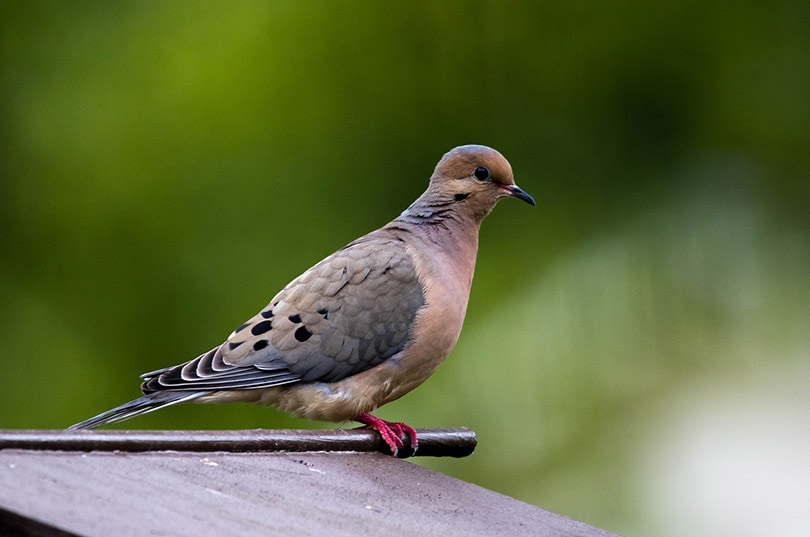
| Population: | 350 million |
| Size: | Medium |
| Colors: | Neutral |
The mourning dove is another ubiquitous bird found in Ohio. These doves are known for their notorious cooing sounds, especially in the evening hours.
Mourning doves are incredibly docile creatures, and some have even been kept as pets. They are kind creatures, mating for life and never seeking out another upon the death of their mate. They also make exceptional mothers who care deeply for their young.
Sadly, these mating pairs are hunted every year, wiping out nearly 20 million birds. While that seems like a big number, it doesn’t hurt their population much. It can, however, leave many doves in actual mourning.
5. Song Sparrow
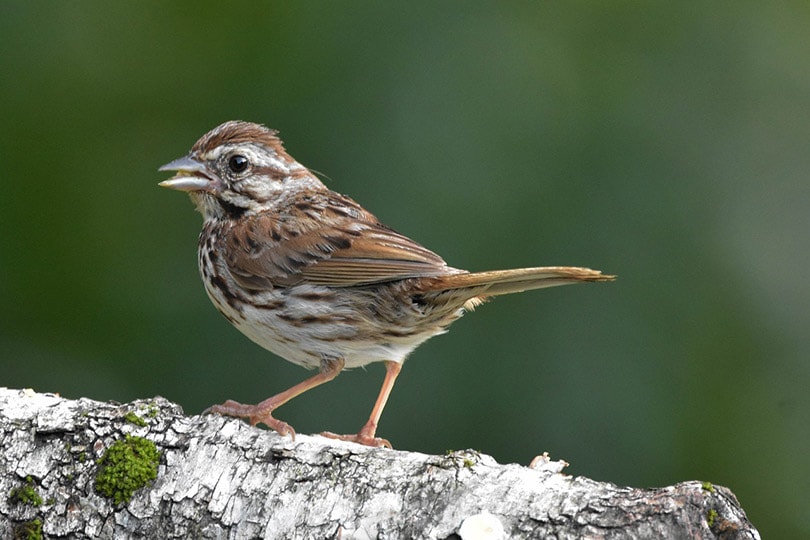
| Population: | 130 million |
| Size: | Small |
| Colors: | Russet and Gray |
The Song Sparrow is an adorable little bird in Ohio in just about any region. They might be small, but their numbers are many. You probably have seen their face and even found a nest or two if you live in the state.
Don’t let their size fool you–the song sparrow is incredibly adaptable and able to withstand the elements. It isn’t uncommon to see a song sparrow building a nest in your front yard tree or handmade birdhouse.
These social creatures enjoy residential areas as well as sparsely wooded habitats. They are often chipper and fast in movement with erratic flight patterns.
6. American Goldfinch
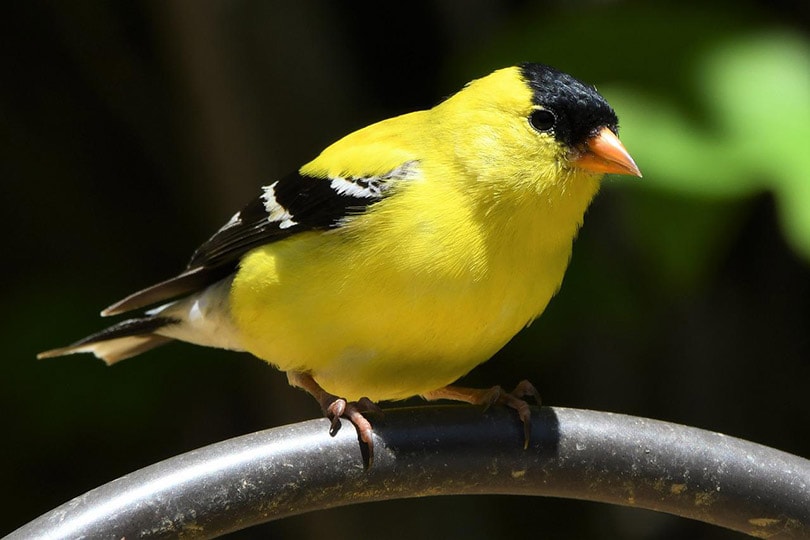
| Population: | 24 million |
| Size: | Small |
| Colors: | Black, yellow |
The American Goldfinch is a real looker, but they are also flighty little zippers. These brightly-colored birds will turn heads, permitting you can catch them in your sight fast enough.
Sexually dimorphic, males have a rich, vibrant yellow feathering, and females are diluted yellow instead. They have small heads and spherical bodies, creating a stout appearance that makes them so darn cute.
Even though these beautiful birds are very noticeable because of their bright colors, it is easy to miss them since they are so small and fast. These birds really enjoy open spaces with tall grasses and can be pretty acrobatic in their movements.
7. Downy Woodpecker
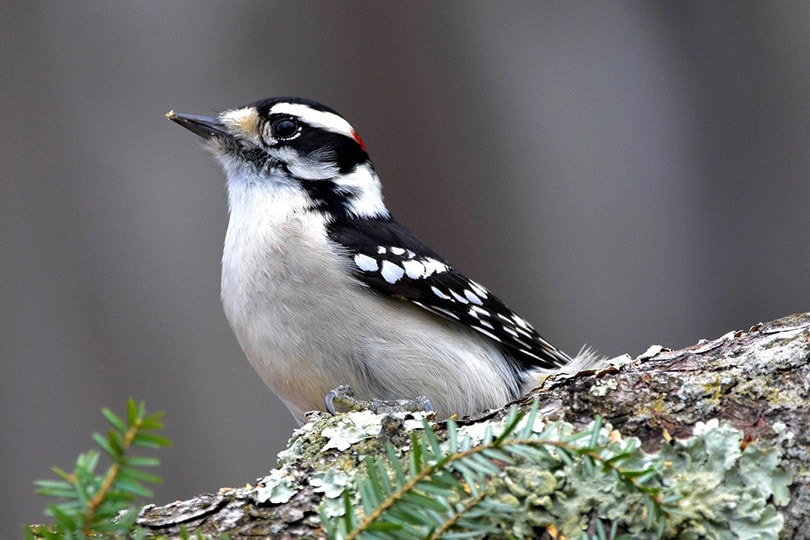
| Population: | 13 million |
| Size: | Medium |
| Colors: | Black, white, red |
As its name might imply, the Downy Woodpecker is a smaller woodpecker variety with fluffy-style feathering. Sometimes confused with the Hairy Woodpecker, these birds tout bold black and white patterns.
Because these little guys spend their time sifting out larva and other insects from trees, they prefer forested or heavily wooded areas. Although, it’s not uncommon for them to come into the backyard for a snack or mingle with the other birds.
Their dimorphism might be hard to detect at first, but upon inspection, you’ll notice that the male has a small red patch on the back of their head, whereas the female does not.
These birds are not quiet creatures, both vocally and with their incessant beak panging on wood. So, they might be a little disruptive if you live in a quiet residential neighborhood.
8. Red-bellied Woodpecker
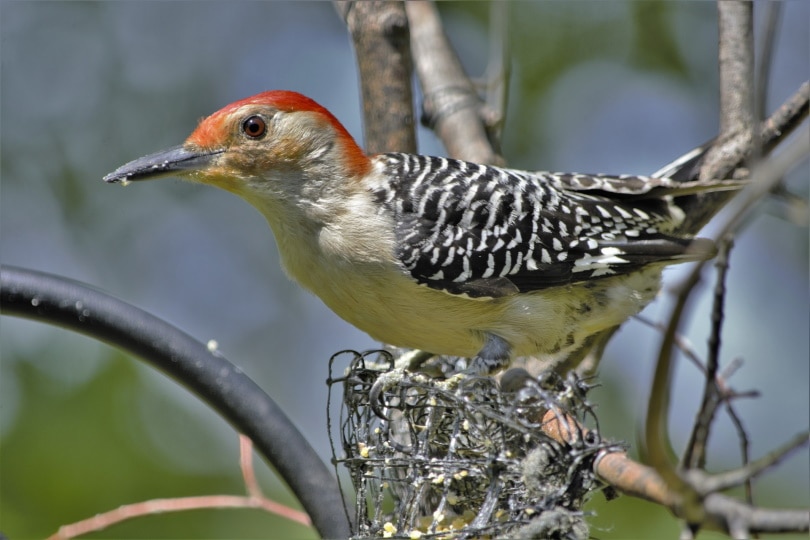
| Population: | 16 million |
| Size: | Medium |
| Colors: | Red, black, white |
Even though these woodpeckers are called “red-bellied,” they are much more recognizable due to their black and white barred pattern on their wings. Males have a more prominent red portion on their heads than females, which is how you can tell the two apart.
These woodpeckers behave like classic woodpeckers, constantly going up and down the trunks of trees to feed on bugs or larvae inside. So, seeing these woodpeckers is much more likely if you have trees in your yard than living in a built-up suburb or city.
Some good news is that these woodpeckers are really bumping up the numbers, expanding over 35% in the past several years. Even though damage can be significant to trees, this woodpecker also positively impacts the environment. Plus, they are simply beautiful to observe in their natural habitat.
9. Red-winged Blackbird
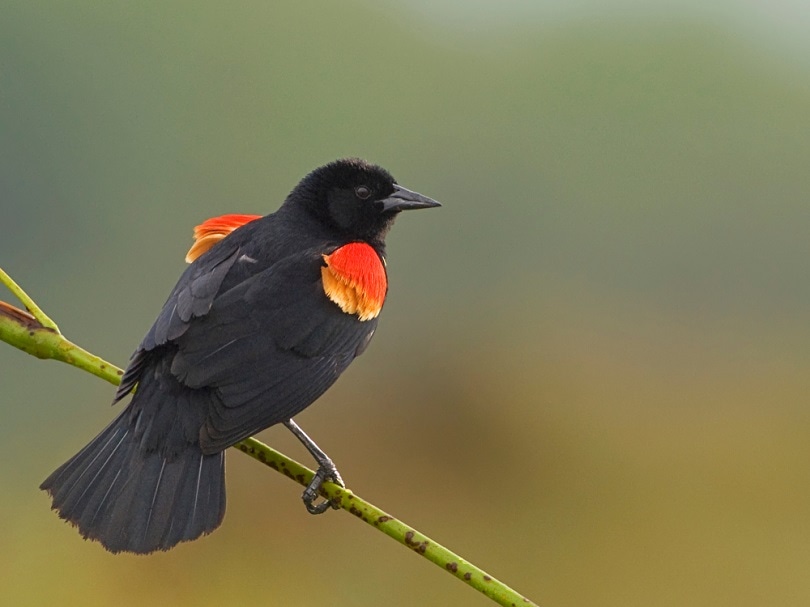
| Population: | 220 million |
| Size: | Small |
| Colors: | Black, yellow, orange, red |
If you have ever seen the Red-winged Blackbird, you might mistake them for something similar, like an Oriole. The blackbird is usually completely black with very vibrant orange or red markings on their wings.
One really cool thing about the Red-winged Blackbird is that they can congregate in large numbers without aggression. In fact, males try to avoid any aggression by hiding their epaulets, or shoulder coloring.
These birds really love the water, so you might find them hanging out on cattails alongside a pond or by a flowing brook. These birds often land in the overgrown brush along roadsides and hop around in open fields, too.
10. European Starling
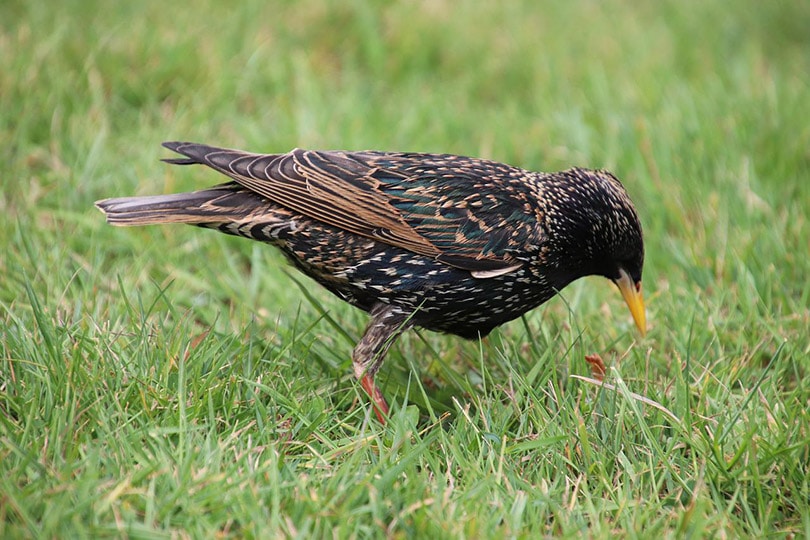
| Population: | 250 million |
| Size: | Medium |
| Colors: | Black, brown, purple-green iridescence, white |
The European Starling might not be native to America, but it sure has made it home here. In the 1890s, European settlers released a group of European Starlings to bring a little piece of the old world with them.
The entire idea behind it was to fill America with Shakespearean favorites. While it took a little while, these birds have made their new home transition a comfortable one—and even make terrific pets in legal situations.
At first glance, these birds might look quite plain, but they are anything but. These birds are charcoal in color with white speckled tummies and decently long beaks. In the winter, they develop a vibrant white on the tips of their wings.
You can find the European Starling in both residential and wooded habitats.
11. American Crow

| Population: | 31 million |
| Size: | Medium/large |
| Colors: | Black |
Of all of the birds Ohio has to offer, none can hold a candle to the intelligence of the American Crow. These birds are mischievous and insanely smart. You can find crows in residential and secluded areas.
Crows have quite an intense history with human beings, commonly associated with witchcraft in black magic. Today, however, we know that crows are among the most impressive birds with
exceptional intelligence.
Because of their overall adaptability, crows are incredibly prevalent in Ohio and across the United States. These birds are known to toy or bully other birds, even large ones like the beautiful hawk.
Even though these birds are incredibly widespread, their population has decreased by 45% since the exposure to the West Nile virus. Luckily crows cannot transmit the West Nile virus between themselves and humans.
12. White-breasted Nuthatch

| Population: | 2 million |
| Size: | Small |
| Colors: | Black, gray, and white |
This list simply wouldn’t be complete without the White-Breasted Nuthatch. They are small species of bird that can sometimes be confused with similar species. These adorable birds are super prevalent in Ohio, adapting to just about any environment Ohio offers. These guys live in residential neighborhoods as well as heavily wooded habitats.
Since these birds are pretty small and very susceptible to predators, they prefer areas where they have access to trees at all times. They need leverage and only visit the ground in rare circumstances to sift out food or mingle with other birds.
These birds pair with the opposite sex and usually stay mates for the majority of their lives. You often don’t see one without the other unless they have not yet reached sexual maturity or one of their mates has passed away.
13. Tufted Titmouse

| Population: | 12 million |
| Size: | Small |
| Colors: | Gray, black |
The little Tufted Titmouse might be one of the most adorable birds in Ohio. These tiny things have a traditional spike on their head, much similar to that of a cardinal. However, they have different coloring, touting shades of bluish-gray and brown.
You might be more prone to seeing these birds in your backyard if you live in a moderately wooded area. They love having a canopy of trees to fly around in, providing security and sustenance.
These little guys love bird feeders as well as integrating with other species. They have no problem with communal eating spaces.
14. House Sparrow

| Population: | 740 million |
| Size: | Small |
| Colors: | Brown |
The House Sparrow might be one of the most widespread species worldwide. You can find them on nearly every continent. These tiny little birds make their homes in almost any environment where there are manufactured structures.
However, they didn’t get their name for nothing These little birds absolutely love to build nests in gutters, chimneys, and holes in houses. You could say they’re quite the little residential builders.
These birds are permanently etched alongside humans, basically domesticating themselves and definitely profiting from our architectural success.
15. Common Grackle
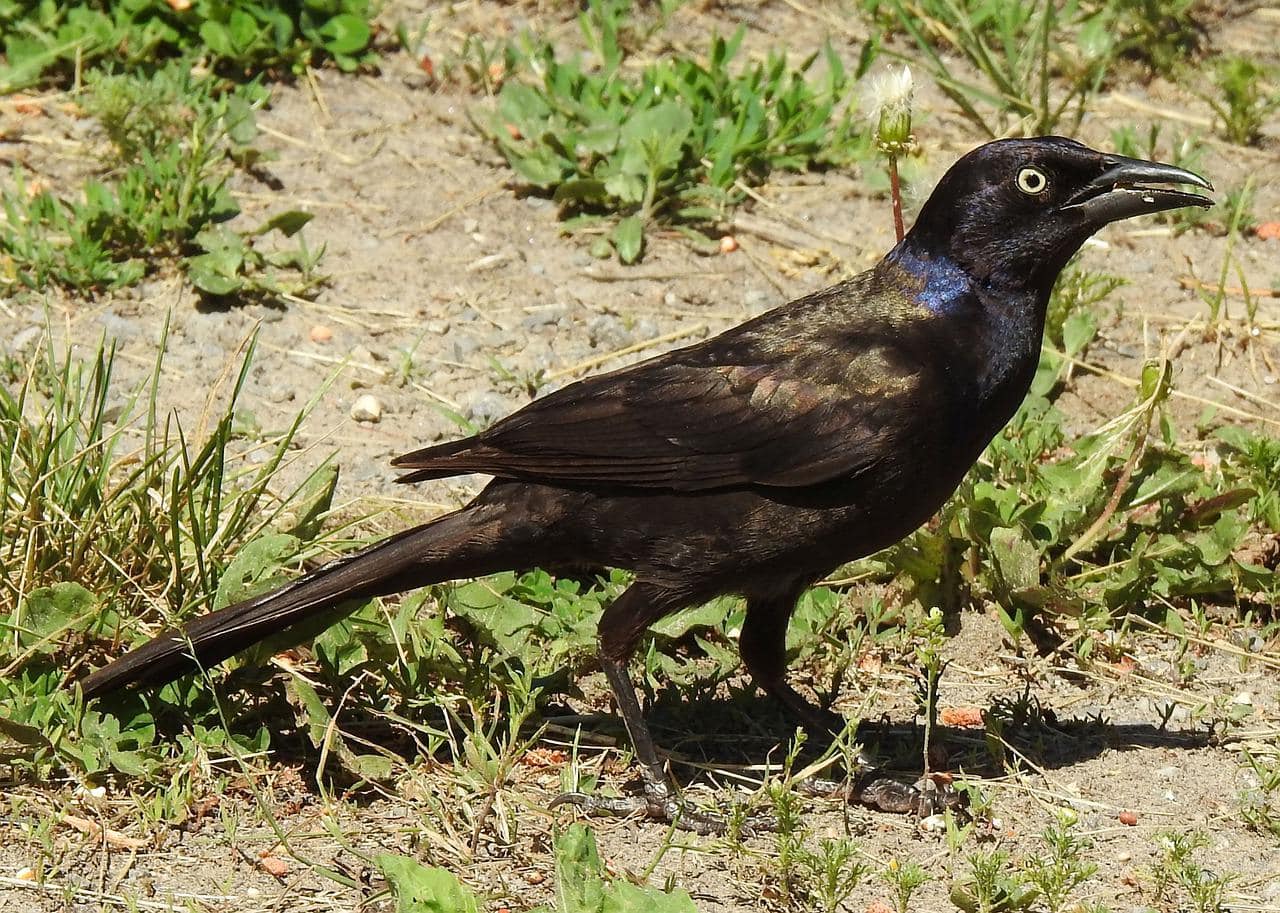
| Population: | 73 million |
| Size: | Medium/large |
| Colors: | Black, blue |
Grackles have a very dark blue head with nearly purplish-black features on the body. Due to their iridescent black coloring, the Common Grackle is often mistaken for a crow. But if you look closely, it is undeniable that the grackle is much smaller, and the coloring does differ slightly.
Grackles are highly social birds among their own kind, gathering in large groups and making all kinds of racket. You could say that they are the hooligans of the outdoors, keeping their neighbors a stir.
Grackles make fantastic foragers, but it might come at the expense of others. They are known to steal food from smaller birds who are less equipped to stop them. However, most of the time, they are generally pleasant.
Also, you might not be able to tell by looking at them, but these birds are directly related to Meadowlarks and Orioles.
16. House Finch
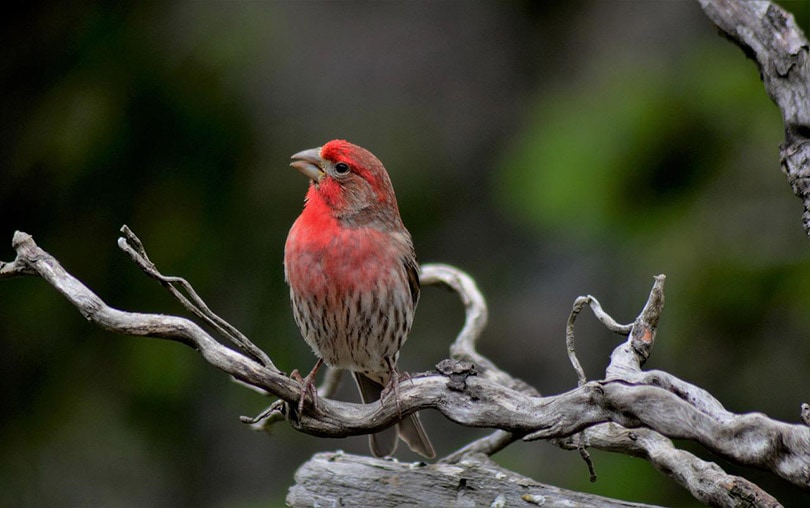
| Population: | 40 million |
| Size: | Small |
| Colors: | Pink, brown |
The house finch is an adorable Ohioan bird that touts mild pink coloring mixed with neutrals. They are small and incredibly fast, so they might fly by in the blink of an eye without you being able to capture a good enough look.
However, they very much enjoy bird feeders. So, if you love feeding birds as you sit on your porch to observe them, you might get a better look.
These little birds get their names honestly, as they tend to build nests in residential areas and pre-built structures. While this is most convenient for them, they can also nest in desert grasslands and open coniferous forests.
17. Carolina Wren

| Population: | 17 million |
| Size: | Small |
| Colors: | Brown |
The Carolina Wren, despite its name, takes up almost every state in the eastern part of the United States. It is very prevalent but easy to blend into the background due to its neutral coloring.
However, it does have a beautiful song that it sings all the time and is one of the most common Ohio songbirds. In fact, once you learn the sounds that they make, you can easily detect them from great distances.
The Carolina wren is not shy about making nests in residential areas. They will find just about anywhere available to raise their young, including gutters, flower pots in the backyard, and old bird boxes.
This cheerful little wren is very docile, getting along with the other birds at the feeder. They also mate for life and can pair up, warm or cold, any time of the year.
18. Carolina Chickadee
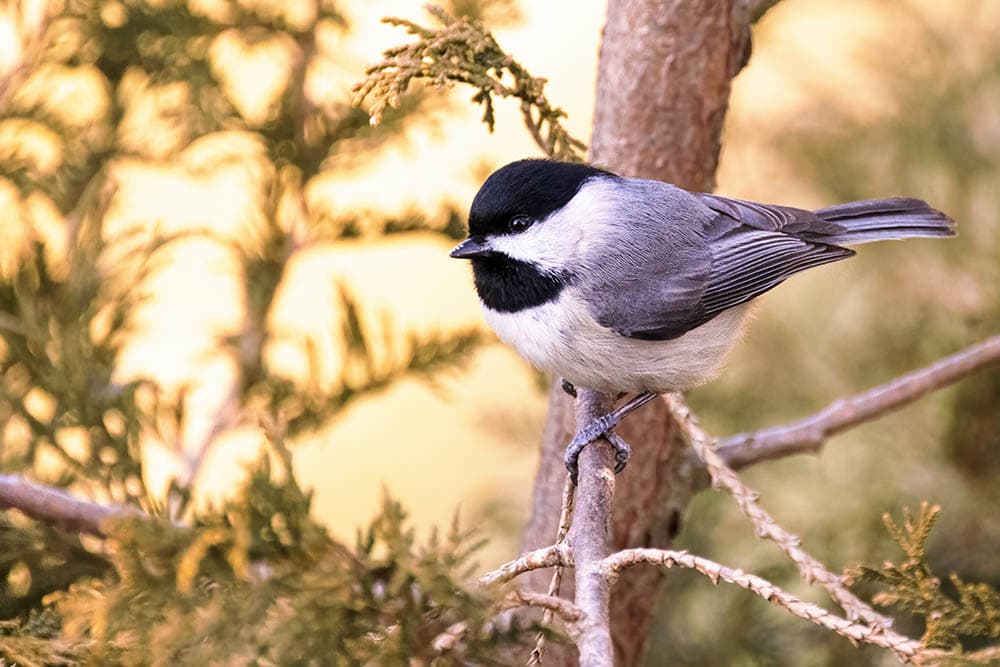
| Population: | 12 million |
| Size: | Small |
| Colors: | Black, yellow |
The Carolina Chickadee is a small, compact little bird often confused with similar breeds such as the Tufted Titmouse. What sets them apart is their smooth black head and defined gray feathering on a spherical body.
The little Carolina Chickadee is a very adventurous and curious spirit. These cheerful birds love feeding in flocks of mixed species where they can safely enjoy meals.
You can find these adorable chickadees fluttering around backyards, parks, and other semi-populated areas with adequate foliage.
19. Gray Catbird
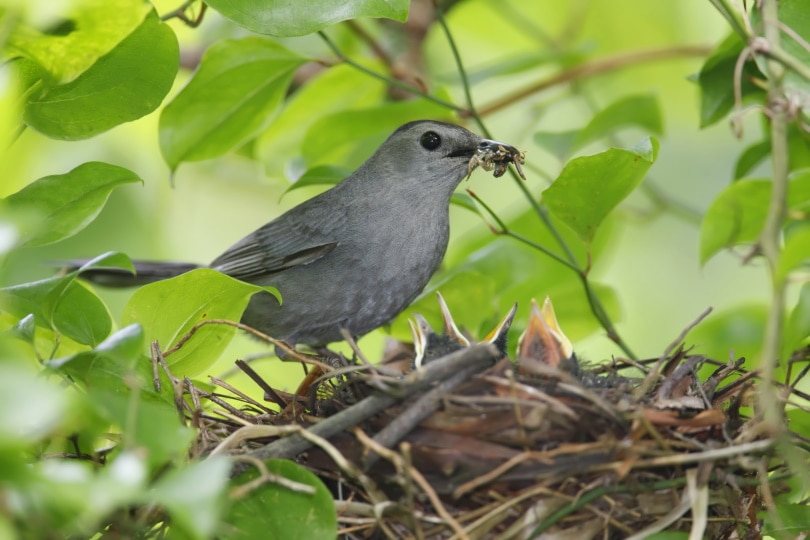
| Population: | 27 million |
| Size: | Medium |
| Colors: | Slate gray |
Even though the Gray Catbird is a very prevalent species in Ohio, they aren’t always so easy to spot. These beautiful gray birds do not enjoy open spaces and prefer to stay low to the ground.
So, you won’t see one flying overhead, but you definitely might see one fluttering from branch to branch in a sparsely wooded area.
Upon first glance, these birds are medium-sized with full gray feathering. However, they do have pops of color on their wings.
These birds generally stay pretty quiet to avoid predators, but they are very energetic and curious in the same sense. They usually nest in thickets and briar patches.
20. Barn Swallow

| Population: | 190 million |
| Size: | Medium |
| Colors: | Blue, tawny |
The beautiful Barn Swallow is a highly prevalent species in Ohio and across the nation. These birds have an incredible flight pattern, touting sharp wings that give these fowl great precision.
They tend to fly close to the ground or over water. If you observe birds during nesting season, you might see barn swallows hanging out near mud puddles or other small muddy water sources to get materials to build their nests.
These birds are very well acclimated to the human species. They love structures and will build mud nests in abandoned houses, barns, and other buildings if they have the opportunity.
Interestingly, this is the most widespread swallow species in the entire world.
21. Indigo Bunting

| Population: | 78 million |
| Size: | Medium |
| Colors: | Blue, brown |
If an Indigo Bunting is around, you’re surely not going to miss them. Standing out with vibrant electric blue color feathers, they are obvious and a lovely sight to behold.
The Indigo Bunting spends most of its time on power lines where it can openly view its surroundings.
It is a bird who loves wide, open spaces.
The Indigo Bunting loses almost all of its color in the fall, turning a neutral brown color. So, it can be a little bit harder to identify depending on what season it is.
However, if you are familiar with the song of the Indigo Bunting, you can probably identify them without recognizing them visually.
22. Pigeon

| Population: | 400 million |
| Size: | Medium |
| Colors: | Gray, blue, green |
If you live in a town or city, there are likely to be almost as many pigeons as people. Pigeons are highly common birds known for their iridescent feathering, friendliness, and array of interesting noises.
Pigeons are just as problematic as they are useful. Since pigeons are one of the most social and tame feral birds around, they naturally congregate with people. Because of this, many people love to feed them, even letting them eat out of their hands.
The integration between pigeons and humans has caused a significant influx in population. These happy birds are more than willing to hang out with a human and even sometimes perch on their shoulder.
While this might seem genuinely impressive, pigeons are more likely to transmit disease to humans and become insanely overpopulated as a consequence. A single female pigeon can give birth to 48 eggs per year so they repopulate quickly.
As the numbers grow exponentially, it does raise many concerns. But we can’t help but love these goofy birds due to their appearance, lovable nature, and social character.
23. Brown-headed Cowbird

| Population: | 56 million |
| Size: | Medium |
| Colors: | Black, dark brown |
It’s easy to overlook the Brown-headed Cowbird, being one of those blendable brown birds in Ohio. Since these birds are a combination of dark brown and black, they tend to mix in with their environment pretty well. However, they have high numbers as a species—which is sometimes problematic.
If you are a bird lover who feeds these fowl in your backyard, the Brown-headed Cowbird might not be one that you want hanging around. They can be extremely aggressive towards smaller species and may even raid their nest and kill their young.
Despite being bullies in the bird world, they have some interesting habits. For instance, they get their name because they tend to hang around cow pastures and other livestock.
When livestock graze, they stir up lots of juicy insects and other snacks for these birds to feast on. So, they are especially prevalent in flatlands and open countryside.
24. Eastern Bluebird

| Population: | 22 million |
| Size: | Small |
| Colors: | Blue, rust, white |
The Eastern Bluebird is a very popular species due to its vibrant, rich blue feathering. They are also notorious for their beautiful song-making skills, being one of the most well-known Ohio songbirds. If you see a bluebird flying in Ohio on a winter’s day, you can rest easy knowing spring is just around the corner.
They are often thought to be spring harbingers, which is a welcome surprise. The Bluebird is related to the flycatcher, tiny little birds that live up to their name.
Even though the Bluebird is not necessarily a monogamous bird, they do mate and stay paired up throughout the mating season while the baby birds are learning the ropes for themselves. Once the season is over, they will pair up with another mate in the following spring.
As with most vibrant colored birds, the females are diluted versions of their male counterparts. They are widely revered in songs, movies, and merchandise—people just love these little blue songbirds.
25. Chimney Swift
https://www.instagram.com/p/CrD2k7kO7pz/
| Population: | 7 million |
| Size: | Medium |
| Colors: | Neutral |
Chimney Swifts are remarkable birds that are extremely important to our environment. In just one day, a single Chimney Swift can eat 12,000 harmful insects that destroy plants, crops, and other forms of vegetation.
These little birds certainly never slow down. The only time that they stop flying is when they’re roosting at night. You’ll never see a Chimney Swift land on the ground, a powerline, or any other perch for that matter.
Otherwise, Chimney Swifts will eat, and drink in flight. It’s no wonder they can power-eat so many insects, as they need them to keep their body weight up from constant physical exertion. It’s really quite impressive.
Unfortunately, these amazing birds are on the decline, going from near threatened to vulnerable status.
26. Cedar Waxwing

| Population: | 52 million |
| Size: | Medium |
| Colors: | Brown, pale yellow, black, orange |
The Cedar Waxwing is quite a sight to behold. They have bulbous bodies with very sharp heads and expressions, with pale yellow bellies, dusty brown feathers, and vibrant colored tips.
They have fascinating markings and extremely tight feathering.
They might only indulge in fruit if you leave it up to a Cedar Waxwing. They love fruit so much that they will eat that above everything else if they have the option.
Cedar Waxwings live primarily in areas with lots of fruit vegetation, such as orchards, prairies, and even close gardens.
27. Killdeer

| Population: | 3 million |
| Size: | Medium |
| Colors: | Brown, black, and white |
One really interesting fact about the Killdeer is the way that they protect their young. Since they develop nests on the ground, predators are afoot naturally.
If they see a predator inching towards their nest, and efforts to prevent danger to their babies, they will act injured, scurrying away from the nest to distract the potential threat.
The Killdeer is known to be quite the chatterbox in the bird world. It seems anytime a Killdeer is around, it is constantly vocalizing, whether it sounds cheerful or panicked. They are not quiet, and you will be able to recognize them a mile away.
Because these birds often walk more than they fly, you’ll notice that they are very zippy and quick.
28. Canada Goose

| Population: | 6 million |
| Size: | Large |
| Colors: | Black, tawny |
The Canada Goose is a type of waterfowl that stays in Ohio most of the year. These are among the largest birds that you’ll find commonplace in the state.
They are notorious for harboring populated areas and frequent waterways. They love swimming in ponds and don’t mind sharing spaces with other waterfowl and people.
However, when they have babies or are mating, they can be notoriously aggressive. They don’t mind chasing you away from their children, but they also don’t mind coming up to a human for a snack.
Canada Geese notoriously fly in V-shaped flocks in the sky. It’s easy to tell when seasons change if you observe these birds in their natural habitat as migration occurs.

Conclusion
You are probably quite familiar with many of the birds on this list. And if you haven’t seen some of these beautiful Ohioan birds, you might notice them now! Maybe, and hopefully, there are a few that you have seen but have not yet been able to identify.
Ohio has many more beautiful bird species that might not be quite as prevalent as those we have mentioned. So, if you’re a bird lover, we implore you to look more into bird identification in the state!
See also:
- 22 Common Backyard Birds in South Carolina
- 33 Common Backyard Birds in Maryland
- 30 Common Backyard Birds in Washington
- 28 Common Backyard Birds in Kansas
Featured Image Credit: Steve Byland, Shutterstock
Table of Contents
- The 28 Most Common Backyard Birds in Ohio
- 1. Northern Cardinal
- 2. American Robin
- 3. Blue Jay
- 4. Mourning Dove
- 5. Song Sparrow
- 6. American Goldfinch
- 7. Downy Woodpecker
- 8. Red-bellied Woodpecker
- 9. Red-winged Blackbird
- 10. European Starling
- 11. American Crow
- 12. White-breasted Nuthatch
- 13. Tufted Titmouse
- 14. House Sparrow
- 15. Common Grackle
- 16. House Finch
- 17. Carolina Wren
- 18. Carolina Chickadee
- 19. Gray Catbird
- 20. Barn Swallow
- 21. Indigo Bunting
- 22. Pigeon
- 23. Brown-headed Cowbird
- 24. Eastern Bluebird
- 25. Chimney Swift
- 26. Cedar Waxwing
- 27. Killdeer
- 28. Canada Goose
- Conclusion
About the Author Ashley Bates
Ashley Bates is animal writer and enthusiast who is currently studying the art of animal therapy. A mother to four human children— and 23 furry and feathery kids, too – Ashley volunteers at local shelters, advocates for animal well-being, and rescues every creature she finds. Ashley's mission is to create awareness and education about animals of all shapes and sizes to promote proper care and respect.
Related Articles:
Monocular vs Telescope: Differences Explained (With Pictures)
10 Types of Hummingbirds in Arkansas (With Pictures)
8 Types of Hummingbirds in Nebraska (With Pictures)
5 Types of Hummingbirds in Idaho (With Pictures)
3 Types of Hummingbirds in Mississippi (With Pictures)
8 Types of Hummingbirds in Kansas (With Pictures)
5 Types of Hummingbirds in West Virginia (With Pictures)
5 Types of Hummingbirds in Ohio (With Pictures)
